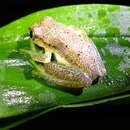en
names in breadcrumbs


Heterixalus punctatus és una espècie de granota que viu a Madagascar.
Heterixalus punctatus és una espècie de granota que viu a Madagascar.
Heterixalus punctatus is a species of frogs in the family Hyperoliidae endemic to Madagascar.[2] Its natural habitats are subtropical or tropical moist lowland forests, swamps, freshwater marshes, intermittent freshwater marshes, arable land, rural gardens, heavily degraded former forests, ponds, irrigated land, and seasonally flooded agricultural land.
Heterixalus punctatus is a species of frogs in the family Hyperoliidae endemic to Madagascar. Its natural habitats are subtropical or tropical moist lowland forests, swamps, freshwater marshes, intermittent freshwater marshes, arable land, rural gardens, heavily degraded former forests, ponds, irrigated land, and seasonally flooded agricultural land.
Heterixalus punctatus es una especie de anfibios de la familia Hyperoliidae.
Es endémica de Madagascar.
Su hábitat natural incluye bosques tropicales o subtropicales secos y a baja altitud, pantanos, marismas de agua dulce, corrientes intermitentes de agua dulce, tierra arable, jardines rurales, zonas previamente boscosas ahora degradadas, estanques, zonas de regadío y tierras de agricultura parcial o temporalmente inundadas.
Heterixalus punctatus es una especie de anfibios de la familia Hyperoliidae.
Es endémica de Madagascar.
Su hábitat natural incluye bosques tropicales o subtropicales secos y a baja altitud, pantanos, marismas de agua dulce, corrientes intermitentes de agua dulce, tierra arable, jardines rurales, zonas previamente boscosas ahora degradadas, estanques, zonas de regadío y tierras de agricultura parcial o temporalmente inundadas.
Heterixalus punctatus Heterixalus generoko animalia da. Anfibioen barruko Hyperoliidae familian sailkatuta dago, Anura ordenan.
Heterixalus punctatus Heterixalus generoko animalia da. Anfibioen barruko Hyperoliidae familian sailkatuta dago, Anura ordenan.
Heterixalus punctatus est une espèce d'amphibiens de la famille des Hyperoliidae[1].
Cette espèce est endémique de Madagascar. Elle se rencontre jusqu'à 900 m d'altitude dans le centre-Est de l'île[1],[2].
Heterixalus punctatus est une espèce d'amphibiens de la famille des Hyperoliidae.
Heterixalus punctatus Glaw e Vences, 1994 è una rana della famiglia Hyperoliidae, endemica del Madagascar.[2]
È una rana di piccola taglia che raggiunge i 22 mm di lunghezza.
Il dorso ha una colorazione grigio-argentea con numerose piccole macchie nere mentre i fianchi ed il ventre sono color giallo-arancio. Lungo i fianchi le due colorazioni sono separate da una linea di macchie nere più fitta. Una banda nera è presente pure tra le narici e gli occhi.
È diffusa nel Madagascar nord-orientale[3], dal livello del mare sino a 900 m di altitudine.
È possibile osservarla all'interno del Parco nazionale di Masoala e nella Riserva speciale di Analamazaotra.
Heterixalus punctatus Glaw e Vences, 1994 è una rana della famiglia Hyperoliidae, endemica del Madagascar.
Heterixalus punctatus is een kikker uit de familie rietkikkers (Hyperoliidae). De soort werd voor het eerst wetenschappelijk beschreven door Frank Glaw en Miguel Vences in 1994. De soort behoort tot het geslacht Heterixalus.[2]
De kikker is endemisch in Madagaskar.[3] De soort onder andere voor in nationaal park Andasibe Mantadia en nationaal park Masoala.
Heterixalus punctatus là một loài ếch thuộc họ Hyperoliidae. Đây là loài đặc hữu của Madagascar. Môi trường sống tự nhiên của chúng là rừng ẩm vùng đất thấp nhiệt đới hoặc cận nhiệt đới, đầm nước, đầm nước ngọt, đầm nước ngọt có nước theo mùa, đất canh tác, vườn nông thôn, rừng trước đây suy thoái nghiêm trọng, ao, đất có tưới tiêu, và đất nông nghiệp có lụt theo mùa.
Phương tiện liên quan tới Heterixalus punctatus tại Wikimedia Commons
Heterixalus punctatus là một loài ếch thuộc họ Hyperoliidae. Đây là loài đặc hữu của Madagascar. Môi trường sống tự nhiên của chúng là rừng ẩm vùng đất thấp nhiệt đới hoặc cận nhiệt đới, đầm nước, đầm nước ngọt, đầm nước ngọt có nước theo mùa, đất canh tác, vườn nông thôn, rừng trước đây suy thoái nghiêm trọng, ao, đất có tưới tiêu, và đất nông nghiệp có lụt theo mùa.